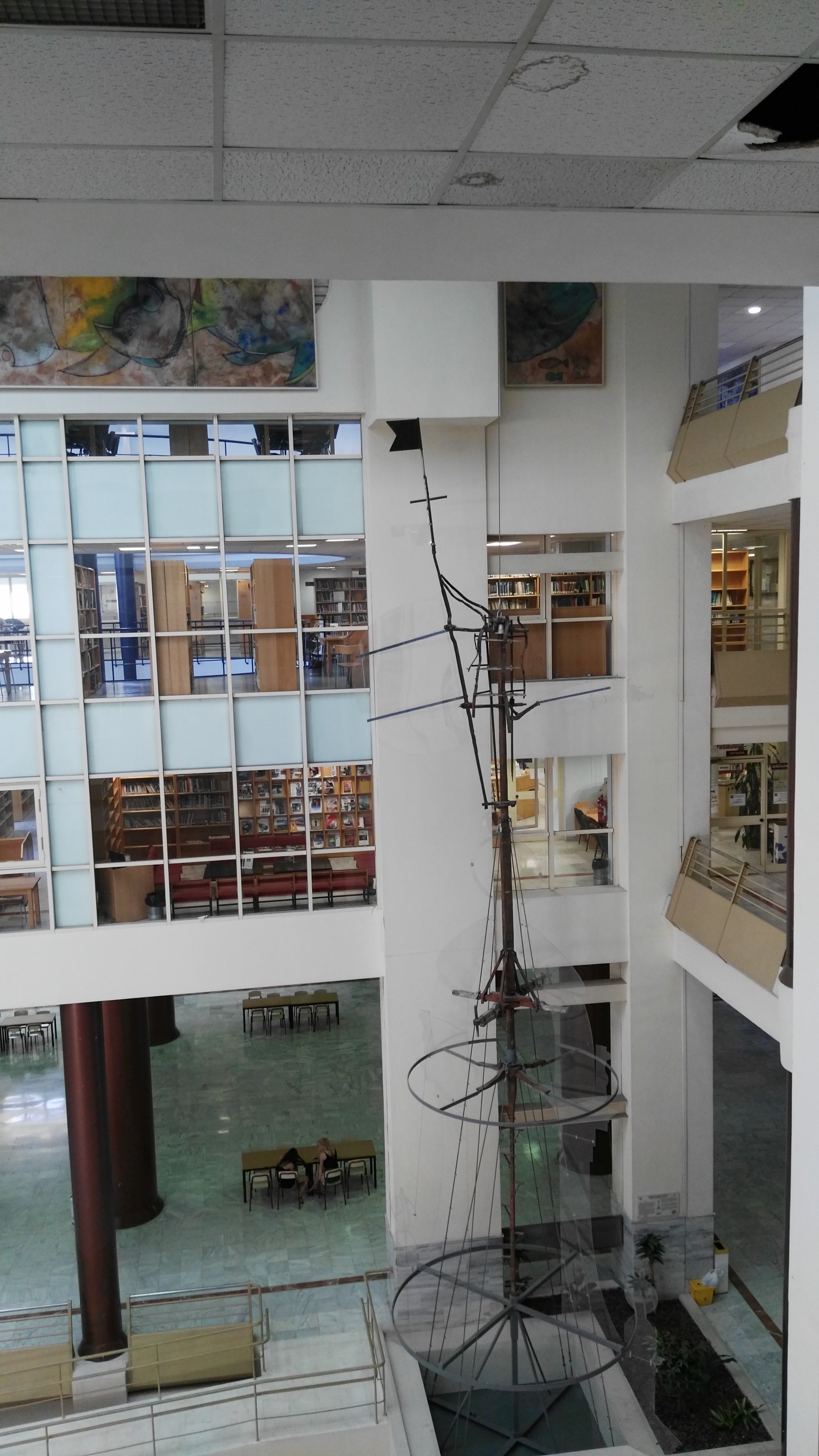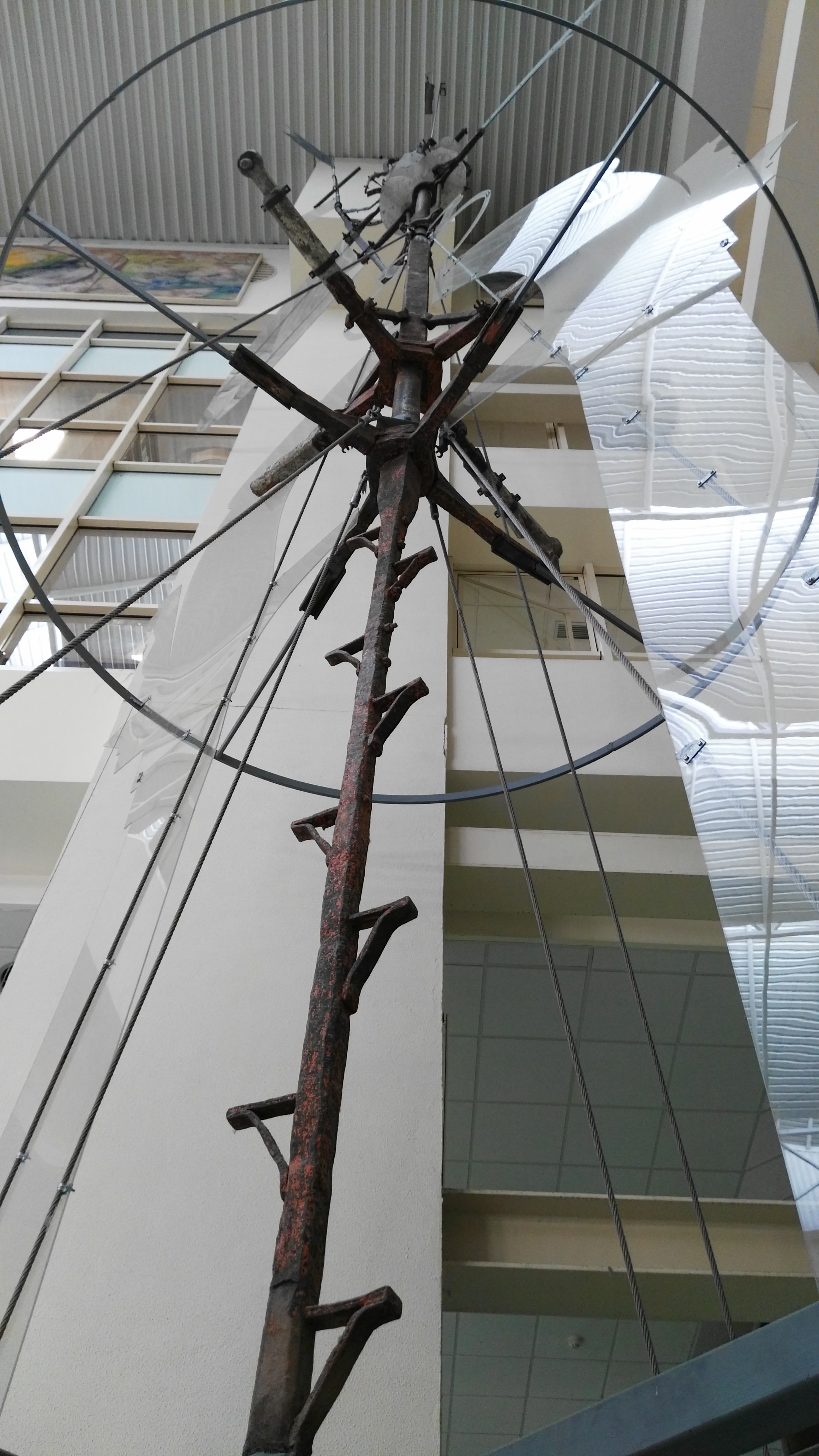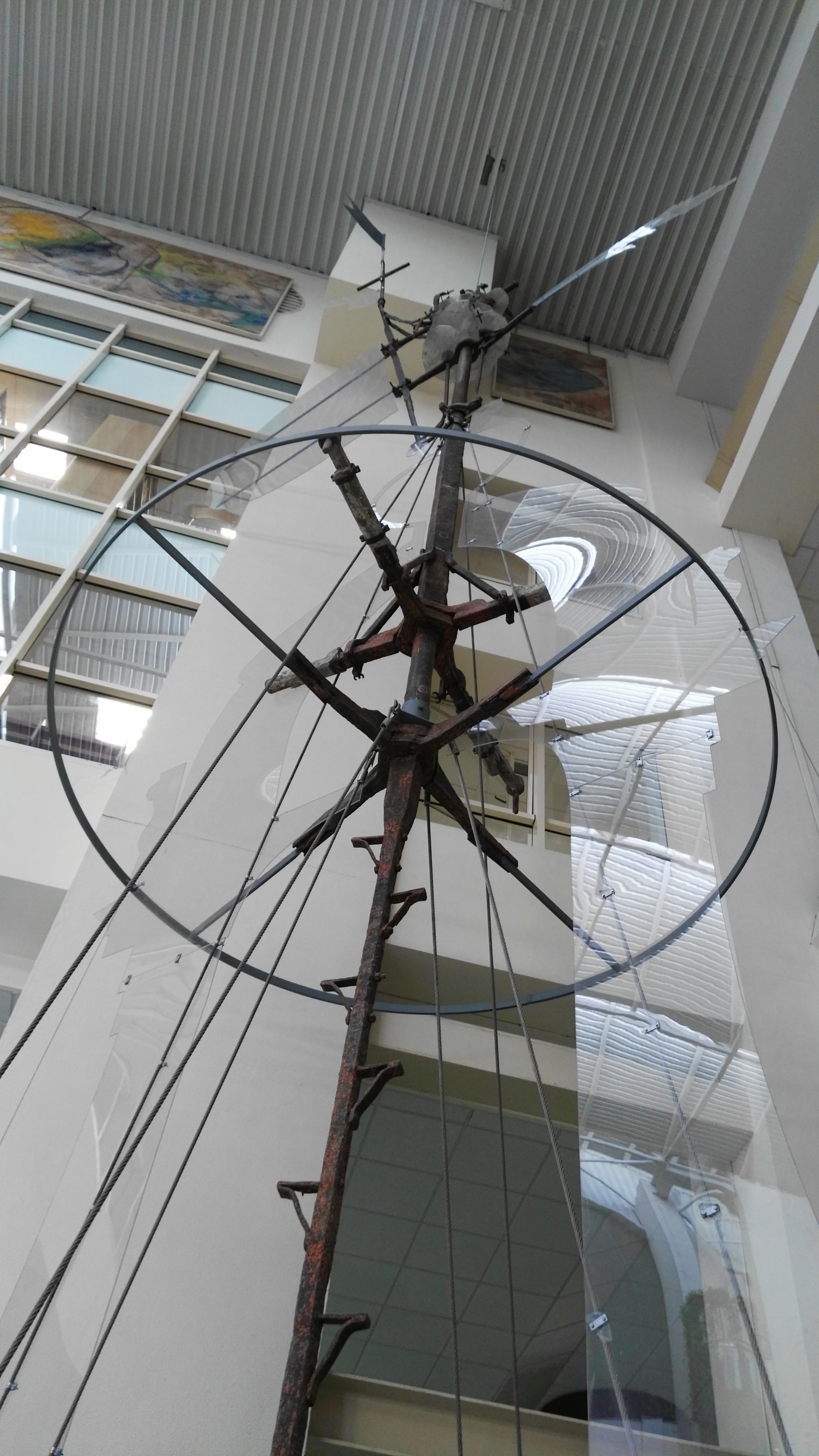Internal structure of “El Giraldillo” (1770-1998)
INTERNAL STRUCTURE OF “EL GIRALDILLO” (1770-1998)
- ID
Name : Internal structure of “El Giraldillo”: Stem and rotating system
Location : Higher Technical School of Engineering (ETSI). Interior patio, West.
Provenance: This one from 1770 is the second internal structure that El Giraldillo has historically had, a bronze sculpture with weather vane functions, as well as aesthetic and symbolic ones, that crowns the Giralda bell tower.
In the profound external and internal restoration to which the sculpture was subjected during the period 1998-2003 (IAPH), the structure was extracted from the weather vane, conveniently studied and cleaned and replaced by the one that is currently in use.
The old pieces corresponding to the 2nd internal structure of the Giraldillo, which had been stored, were temporarily transferred to the ETSI by the Cabildo of the SMPI Cathedral of Seville for exhibition at the School on the occasion of the 25th anniversary of AICIA (Association of Research and Industrial Cooperation of Andalusia) in 2007.
Its assembly and enhancement in the place it currently occupies was directed by the School's professors who had been part of the large interdisciplinary team in charge of this latest restoration process. Assembly carried out by the company Joaquín Pérez e Hijos.
- Technical characteristics
Measurements : 6.48 m. (5.4 m.: from the upper drum to the tip of the shaft) // Weight : 835 Kgs. (approximately 500 Kgs. would be the weight of the stem or shaft, from the upper crosshead of the body of the Plume to its upper end) .
Material : Wrought iron
It is on display, fastened with straps and surrounded by a methacrylate silhouette that gives an idea of its original position inside the Giraldillo sculpture.
Use : For almost three centuries, from 1700 to 1998, this structure of bars constituted the support axis and the rotation system that allowed the movement of the sculpture (and weather vane) of the La Giralda bell tower. This spike or inner axis, of variable diameter with a minimum value of 7 cm, supported and allowed the rotation of the enormous bronze statue, 3.5 meters high and weighing 1,705 kg. [Large bronze sculptures are hollow. The bronze skin, a few cm long. thick, it is not capable of supporting the weight of the figure, so it has to be reinforced internally with an iron structure (or steel in more recent times)]. The structure was described at the time as “mechanical ingenuity”, given that the rotating mechanism it incorporated represented an important technological innovation at the time.
General description : The internal structure formed a kind of hanger from which the bronze sculpture of Giraldillo hung. It is composed of three more or less horizontal elements ( crossbars ) that crossed the body at different heights, and three approximately vertical elements ( internal braces and flagpole ) that connected the previous ones to each other. All of them forged elements, built by hand, so they do not have a constant section or regular geometry.
– The crossbars are located at the height of the Giraldillo's feet, thighs and chest.
– The axis, embedded in the tower, crosses the two lower crossbars through the rings in their central part and ends in the shape of an ogival point, which fits into the bronze central piece of the upper crossbar at chest height, being the only point of vertical support and turning bearing of the sculpture and its internal structure.
– Part of the Giraldillo's feet rested on the lower horizontal crossbar , and at one end the bar that acts as the mast of the labarum or flag is attached.
– The intermediate crossbar has a downward trajectory from left to right. It was attached to the bronze of the sculpture on the left thigh and crossed it on the right, reaching the element that joined it to the mast and the flag by means of a pair of screws. Also at this height, the bar inside the palm of the sculpture was joined to the left internal brace, through a triangulation that constituted one of the deficiencies of the structure, as it did not correctly fulfill the function of transmitting the weight of the palm. , and from the force of the wind acting on it, to the internal structure.
– The upper crossbar at chest height had, as mentioned, a hole in its central part where the bronze bearing in which it was attached was housed (and is housed because it is the only element that remains in the current structure). the tip of the shaft, forming the turning bearing of the vane. This crossbar was joined to the bronze of the sculpture on the left shoulder, it crossed the arm of the sculpture, which was supported on the crossbar by means of wedges and, like the intermediate crossbar, it was joined by screws to the flagpole and the structure of the labarum.
-The internal braces and the flagpole connected the transverse elements. They were generally found in a satisfactory state of conservation, except for the very high degree of corrosion at the lower end of the left brace, which crossed the left leg of the Giraldillo, due to which it had completely disappeared. This prevented the correct transmission of forces between the lower and intermediate crossbars, producing imbalance and poor functioning of the assembly.
– Internal reinforcements in the form of staves ran throughout the structure. The staves or straps were joined to the sculpture by means of bolts. They were placed in 1770 to reinforce deteriorated areas of the sculpture that had cracks or lack of material.
– The sculpture, with its internal structure, is very well balanced, since the center of gravity of the set is located laterally at 2 cm. of the position of the Vane axis. The imbalance that causes the statue to lean on the side of the labarum and the slight inclination towards its back are small given the complicated geometry of the set, its period and its construction process. From a technical point of view, its design as a weather vane was successful and its construction was precise. (Domínguez Abascal, José ; Solís Muñiz, Mario, 2009)
- Cataloging-Documentation
Date: 1770
Builder /Brand: Author unknown
Country Spain. City: Seville
Serial No. and Model: ——
Technical description: Information also derived fundamentally from studies published after the last restoration process of the Giraldillo in which the structure was replaced.
– The extraction of the internal structure from 1770 constituted the 1st phase of the comprehensive restoration process of the Giraldillo (1998-2003), as a previous step to carry out the interior and exterior cleaning of the sculpture. Although conceived as a removable assembly, its disassembly was a very laborious process due to the poor state of conservation of the joints between the different pieces, because some had been soldered in subsequent restorations and because mechanical operations and manipulations could not affect or damage this sculpture at the top of the Giralda, declared an Asset of Cultural Interest and World Heritage Site.
The Giraldillo remained in a horizontal position throughout the entire process of study, disassembly, construction and assembly of the new structure. Firstly, the iron staves that reinforced the sculpture internally, all affected by a high degree of corrosion, were extracted through the hole in the chest or the door on the right hip.... Subsequently, the pieces that served as a connection between the bars of the structure and the sculpture, which functioned as bushings and wedges, were removed.
The disassembly of the bar structure required the cutting of the threaded ends of its pieces due to the corrosion of the nuts that joined them. * The cut pieces, once the structure was completely disassembled, would be welded again so that the internal structure of 1770 could be seen as a whole.
To extract the part of the structure that was inside, the so-called “fabric knot” on the left of the statue and part of the sheet metal that covers its lower part had to be dismantled. From the primitive structure of 1565, a remains of iron metal was found near the left shoulder of the sculpture.
The large piece in the chest area where the bearing on which the sculpture rotated was located, a function lost a few years ago, had to be removed after removing the solder from the copper sheet that covered it. The dismantling of the structure allowed us to examine its details and its state of conservation. In addition to the inadequate design of some elements, the high level of oxidation of the entire assembly was confirmed, with spectacular corrosion in some points, such as the aforementioned lower end of the left brace, which had disappeared.
It was also possible to appreciate “the complexity of the geometry and its magnificent execution, not only by the shape of each element separately (with breaks in its trajectory, changes in section, shape of the joints, etc.), but also by the arrangement of the whole: there is an absolute absence of parallelism or orthogonality in the trajectories of the elements, which are logically conditioned by the shape of the sculpture.” (Domínguez Abascal, José ; Solís Muñiz, Mario, 2009).
– Cleaning of the old structure: A specific treatment for ferrous materials was applied. A superficial cleaning removed remains such as the minium applied in old interventions. Mechanically, several alterations were treated: adhesions, exfoliations, oxides... Subsequently, the iron was stabilized with 5% tannic oxide in alcohol and the metal was protected with acrylic resin and microcrystalline wax.
– The analysis of its old internal structure and its mechanical behavior before different actions through the Finite Element Model, provided the necessary information to design and build the new support and rotation structure of the Giraldillo, which also recovered its function and mobility. vane. The new Giraldillo structure largely respects the design of this 1770 structure (criterion of minimal intervention in the restoration), although with certain modifications that correct some deficiencies and improve its interrelation with the sculpture. It is made of AISI 316L stainless steel. It includes a remote control and inspection system using sensors to monitor the operation of the vane, record the actions to which it is subjected, and detect possible deterioration. In addition, a program of periodic reviews was foreseen.
- Conservation status: Good
- Observations : 5.1. Brief history: – As we have already advanced, in 1770 this structure replaced the original internal structure existing in the bronze sculpture that we know today as El Giraldillo (because it rotates), also historically called “The Colossus of the Victorious Faith”, the Holy Joan, etc., made in the mid-16th century (1565-1568). Built before the sculpture, in 1565, it was the work of the blacksmiths Juan Pozo and Cosme de Çorribas. – The passage of time (almost 2 centuries) and the Lisbon Earthquake of 1755 had led the original structure to a state of corrosion and deterioration, perfectly documented, which made it advisable to replace it. The intervention was carried out by Pedro Miguel Guerrero, author of the diagnosis and designer of the structure, and Manuel Núñez, Senior Master of the Cathedral, in charge of its dismantling and assembly. * A color drawing with extensive legend, made by Pedro Miguel Guerrero and preserved in the Archive of the SI Cathedral of Seville, contains drawings of the original structure and the new one and reports in detail on this restoration of 1770 in the “Vandera, Bolt, Statue, and aderentes…”, also indicating that it offers “…a punctual explanation of the order in which they were placed, which will serve to assemble and disassemble with ease and good economy the entire Upper Finish of said Tower, when an accident requires it. of the times…”- Image credit: Photos and old postcards of Seville]. 5.2. Next to the place where the internal structure of the Giraldillo is installed at the ETSI, there is an information plaque that, with the title “Scion of the Giralda and Giraldillo Turning System (1770-1998)”, describes its shape, characteristics techniques, considerations about its place and execution procedure and about its parts and elements. He also reports that the section of the low crosshead and the bolt on which it rests do not correspond to 1770, but are a replica of the one already replaced in 1886 by Fernández Casanova, which is still currently installed in El Giraldillo. In the background, the drawings and corresponding legend prepared after the restoration of the Giraldillo of 1770 can be seen blurred. 5.3. We conclude with the allusion to the weather vane contained in the Second Part of Don Quixote (Chapter 14), when the Knight of the Forest relates to Don Quixote the commands of his beloved Casildea de Vandalia..., in these terms: "...Once he ordered me to was to challenge that famous giantess of Seville called Giralda, who is as brave and strong as she was made of bronze, and without moving from one place she is the most mobile and willful woman in the world. I arrived, watched and defeated it, and made it be at bay, because in more than a week nothing but north winds blew… ”
- Bibliography and Sources / More information:
-Bells of the Cathedral of Valencia. The colossus of Seville [online]. 2016 Available at: http://campaners.com/php/textos.php?text=2138 [Consulted: 03-22-2019]
– El Giraldillo is also in the ETSI. Information Bulletin Higher Technical School of Engineers, n. 5 (April 2008), p. 4-5. Available at: https://appsetsi.us.es/archivos/informacion/revistas/documentos/r05.pdf [Accessed: 09-30-2024]
– ** DOMÍNGUEZ ABASCAL, José ; SOLÍS MUÑIZ, Mario. Mechanical-resistant behavior; Mechanical intervention. In El Giraldillo: the weather vane: research and intervention project . Andalusian Institute of Historical Heritage; (ed. coordinator, Rosario Villegas Sánchez; Román Fernández-Baca, dir.). – Seville: Ministry of Culture, 2009. Notebooks PH 24, Cap. 5 (p. 103-138) and Chap. 7 (pp. 163-181). Available at: http://www.iaph.es/web/canales/publicaciones/cuadernos/cuadernos-ph/contenido/Cuadernos/CuadernoXXIV [Consulta22-03-2019]
– El Giraldillo [online]. Blog Postcards and old photos of Seville , January 7, 2016. Available at: http://postalesyfotosantiguasdesevilla.blogspot.com.es/2016/01/el-giraldillo.html [Accessed: 03-22-2019]
– ANDALUZIAN INSTITUTE OF HISTORICAL HERITAGE (IAPH). Catalog of restored works. The Colossus of Victorious Faith . Available at: http://www.iaph.es/web/canales/conservacion-y-restauracion/catalogo-de-obras-restauradas/contenido/El_Giraldillo [Consulted: 03-22-2019]
– RODRÍGUEZ, Lola. Ingenieros rescues the authentic backbone of the Giraldillo from oblivion. ABC de Sevilla , May 25, 2008. Available at: https://sevilla.abc.es/home/sevi-ingenieros-rescata-olvido-autentica-espina-dorsal-giraldillo-200805250300-1641890980064_noticia.html [Consulted: 09-30 -2024]



